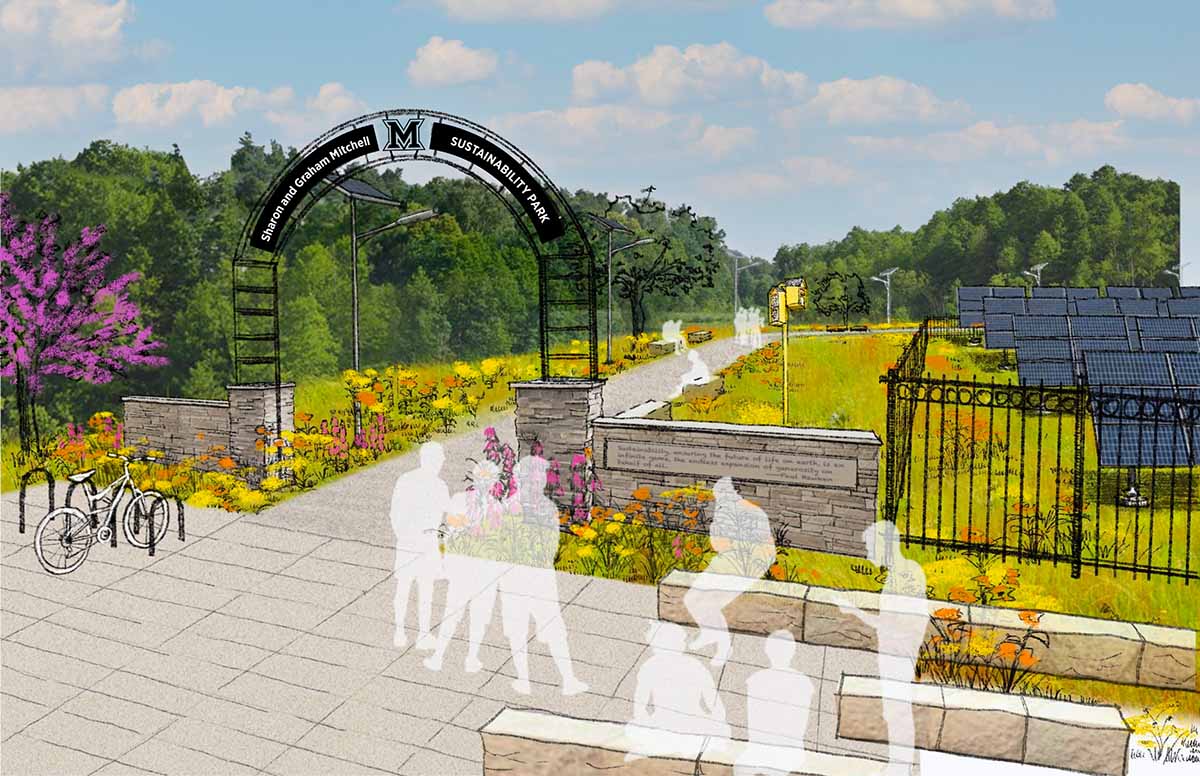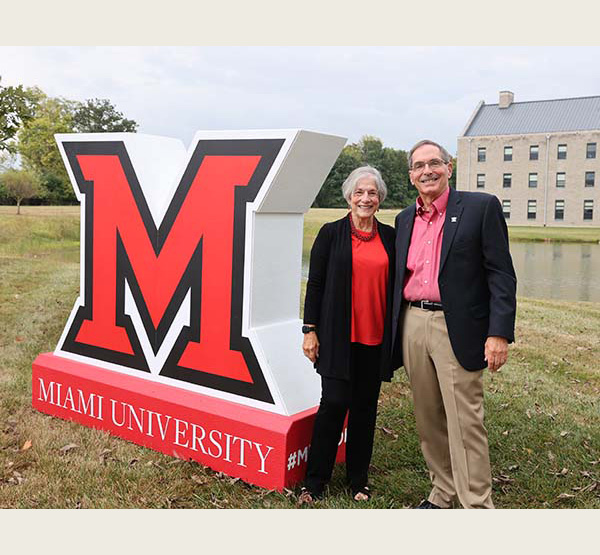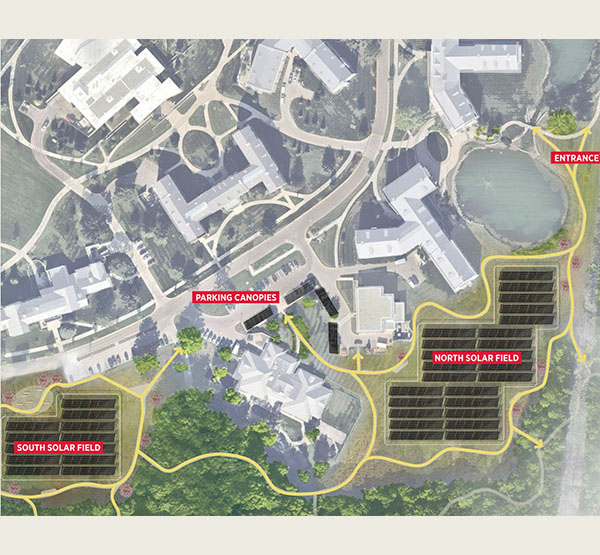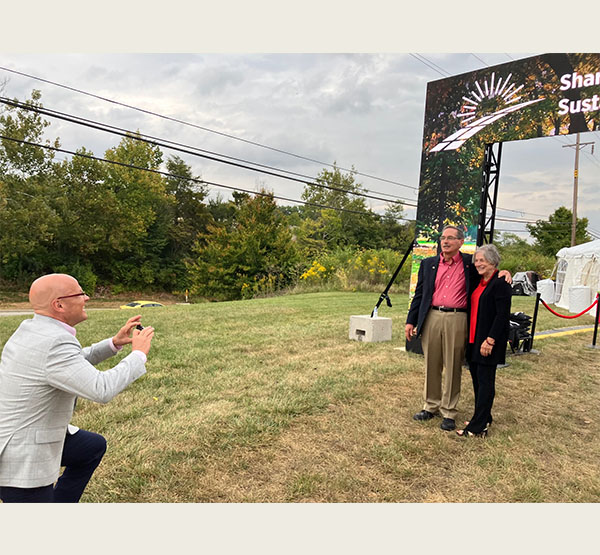'Flipping the switch' on the Sharon and Graham Mitchell Sustainability Park at Miami University
A $5 million gift from Sharon Janosik Mitchell ’73 and Graham Mitchell ’73, M.En. ’76 will help Miami reach its 2040 carbon neutrality goal

'Flipping the switch' on the Sharon and Graham Mitchell Sustainability Park at Miami University

“When we heard President Crawford declare that Miami is committed to carbon net neutrality by 2040, and we heard him talk about Miami’s approach to get there by changing our own campus space — not buying carbon credits, well, it aligned perfectly with the change we want to be,” Sharon Mitchell said.
“We were inspired to work with Miami on the expansion of their sustainable energy program by adding solar to the already strong geothermal energy program we already have,” she said.
Graham Mitchell said, “This land where we are standing was once the homeland of the Miami Tribe. We think it is very fitting that we honor the Miami Tribe by using part of this space to honor, respect, and invest in sustaining our planet.”
Student speaker Will Sayner, a combined Masters in Environmental Science student and a junior Botany major and Environmental Science co-major, said, “My generation needs your help if we are to solve the climate crisis.” Sayner, in his second year working as a student assistant in Miami’s Office of Sustainability through Miami’s Service+ AmeriCorps program, said, “I want my children to be able to experience the world without worrying about the death of our planet. Miami University is a great example of how we can accomplish our sustainability goals and support future generations.”
“Being part of this solar array installation and this Sustainability Park is very exciting – and we are thrilled and honored to be part of it,” Sharon said.
A future fundraising plan will give others a chance to participate by purchasing a solar panel for the project.

Western Geothermal Solar Fields
Miami will break ground this winter in preparation for two ground mount solar photovoltaic (PV) installations.
The Geothermal (North) Solar Field will be located north of the Western Geothermal Plant and adjacent to Hillcrest Hall near the Western Upper Pond, situated above the Western Geothermal well field.
The Thomson (South) Field will be situated at the current site of Thomson Hall, which is scheduled for removal this winter, according to Cody Powell, associate vice president, Facilities Planning and Operations.
Installation of the solar PV panels is planned for late spring/early summer 2025.
The combined solar fields — Western Geothermal and the Thomson site — are expected to produce 2,260 megawatt hours (MWh) of electricity annually.
The project cost for the solar fields is expected to be between $4 million and $4.5 million, according to Powell.

About the donors
Sharon Janosik Mitchell ’73 dedicated her entire career to Procter & Gamble, eventually retiring in 2009 as the senior vice president for Research and Development in Global Fabric Care. As a passionate inventor, she proudly holds four U.S. and three international patents.
She has served in various leadership roles, including 25 years on the Miami University Research Advisory Committee, being a founding member of the College of Arts and Science Advisory Board and MIAMI Women, and chairing the Board of Trustees and the Miami University Foundation Board. She helped lay the groundwork for Miami’s sustainability work–helping to create and approve Miami’s geothermal program while on the Board of Trustees. She continues her involvement as a member of the National Campaign Steering Committee and the Miami University Foundation Board of Directors.
Graham Edwin Mitchell ’73, M.En. ’76 worked for 29 years at the Ohio Environmental Protection Agency, focusing on surface water and tackling the investigation and cleanup of federal facilities. From 1985 to 1994, he was the lead regulator for a remediation project at Fernald, a former uranium metals production plant in Southwest Ohio. His work was the foundation for transforming Fernald from a Cold War legacy site to a beautiful nature preserve consisting of 385 acres of native grasslands, seven miles of accessible trails, and more than 100 different animal species. After retiring in 2006, he has contributed his expertise broadly–chairing Cincinnati Nature Center’s board, serving on the board of Ohio Environmental Council, and providing leadership on the boards of two land trusts, which led to him being named “Conservationist of the Year.”
Graham has also remained deeply involved, contributing to boards like the College of Engineering and Computing External Advisory Council, the Sigma Phi Epsilon Alumni Board, and the National Campaign Steering Committee.